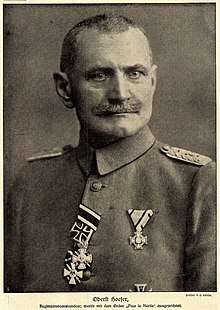Karl Höfer

Karl Hoefer in 1916
Karl Höfer (also Hoefer; 1862 in Pleß – 1939) was a German general. During World War I he became known as the Held vom Kemmelberge[1] (hero of Kemmel hill) after his division had captured the Kemmelberg during the Fourth Battle of Flanders.
Retired, as "Generalleutnant a. D.", Höfer defended German Upper Silesia against Polish insurgents in the Silesian Uprisings in 1921. The Freikorps leaders had agreed[2][3] upon Höfer as commander; he led them to success in the Battle of Annaberg. In the international press, he was referred to as "General Hoefer" or "Teuton Commander Hoefer".[4]
Works
- Karl Hoefer: Oberschlesien in der Aufstandszeit, 1918-1921: Erinnerungen und Dokumente, published by E.S. Mittler & Sohn, 1938, 376 pages[5]
- reviewed by H. F. P. Percival, International Affairs (Royal Institute of International Affairs 1931-1939), Vol. 17, No. 6 (Nov. - Dec., 1938), pp. 853–854 (review consists of 2 pages)[6]
Notes
- ↑ Andreas Dornheim: Röhms Mann fürs Ausland
- ↑ Dornheim
- ↑ The German Freikorps 1918-23, By Carlos Caballero Jurado, Ramiro Bujeiro
- ↑ "SILESIAN CRISIS DECLARED AT END BY THREE GENERALS; Teuton Commander Hoefer and Polish Leader Korfanty Yield Finally to Allies. GERMANS QUIT ANNABERG Will Alternate With Poles in Falling Back To and Across Their Respective Frontiers. ALL TO BE OUT IN TEN DAYS British-French-Italian Army Ready to Act Instantly, if Necessary, to Enforce Agreement". The New York Times. June 27, 1921.
- ↑ Karl Hoefer (1938). "Oberschlesien+in+der+Aufstandszeit,+1918-1921" Oberschlesien in der Aufstandszeit, 1918-1921. E.S. Mittler & sohn.
- ↑ JSTOR 3019448
| Wikimedia Commons has media related to Karl Hoefer. |
This article is issued from
Wikipedia.
The text is licensed under Creative Commons - Attribution - Sharealike.
Additional terms may apply for the media files.